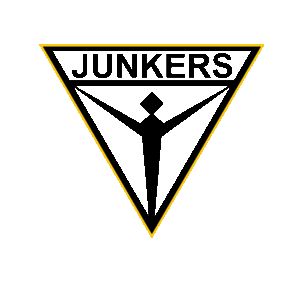
The Junkers Ju 52 is a transport aircraft that was designed and manufactured by German aviation company Junkers.
The Ju 52 had a low cantilever wing, the midsection of which was built into the fuselage, forming its underside.
It was formed around four pairs of circular cross-section duralumin spars with a corrugated surface that provided torsional stiffening.
A narrow control surface, with its outer section functioning as the aileron, and the inner section functioning as a flap, ran along the whole trailing edge of each wing panel, well separated from it.
The inner flap section lowered the stalling speed, and the arrangement became known as the Doppelflügel, or “double wing”.
The outer sections of this operated differentially as ailerons, projecting slightly beyond the wingtips with control horns.
The strutted horizontal stabilizer carried horn-balanced elevators which again projected and showed a significant gap between them and the stabilizer, which was adjustable in-flight.
All stabilizer surfaces were corrugated.
The Ju 52 featured an unusual, corrugated duralumin metal skin, which had been pioneered by Junkers during the First World War; the corrugation served to strengthen the whole structure over a smoother approach.
The fuselage was of rectangular section with a domed decking, comprising a tubular steel structure that was entirely covered by the corrugated metal skin.
A port-side passenger door was placed just aft of the wings; this entrance also acted as a loading hatch for freight, the lower half functioning as a platform to ease cargo movements.
The cabin had a dimensional capacity of 590 cubic feet and was lined with numerous windows stretching forward to the pilots’ cockpit.
The main undercarriage was fixed and divided; some aircraft had wheel fairings, others did not.
A fixed tailskid, or a later tailwheel, was used.
Some aircraft were fitted with floats or skis instead of the main wheels.
In its original configuration, designated the Ju 52/1m, the Ju 52 was a single-engined aircraft, powered by either a BMW IV or Junkers liquid-cooled V-12 engine.
However, the single-engined model was deemed to have been underpowered and, after seven prototypes had been completed, all subsequent Ju 52s were built with three radial engines as the Ju 52/3m.
Originally powered by three Pratt & Whitney R-1690 Hornet radial engines, later production models mainly received 574 kW (770 hp) BMW 132 engines, a licence-built refinement of the Pratt & Whitney design.
Export models were also built with 447 kW (600 hp) Pratt & Whitney R-1340 Wasp and 578 kW (775 hp) Bristol Pegasus VI engines.
The two wing-mounted radial engines of the Ju 52/3m had half-chord cowlings and in planform view (from above/below) appeared to be splayed outwards, being mounted at an almost perpendicular angle to the tapered wing’s sweptback leading edge (in a similar fashion to the Mitsubishi G3M bomber and Short Sunderland; the angled engines on the Ju 52 were intended to make maintaining straight flight easier should an engine fail, while the others had different reasons).
The three engines had either Townend ring or NACA cowlings to reduce drag from the engine cylinders, although a mixture of the two was most common (as can be seen in many of the accompanying photographs), with deeper-chord NACA cowlings on the wing engines and a narrow Townend ring on the centre engine (onto which a deeper NACA cowl was more difficult to fit, due to the widening fuselage behind the engine).
Production Ju 52/3m aircraft flown by Deutsche Luft Hansa before the Second World War, as well as Luftwaffe-flown Ju 52s flown during the war, usually used an air-start system to turn over their trio of radial engines, using a common compressed air supply that also operated the main wheels’ brakes.
In a military context, the Ju 52 could carry up to 18 fully equipped soldiers, or 12 stretchers when used as an air ambulance.
Transported material was loaded and unloaded through side doors by means of a ramp.
Air-dropped supplies were jettisoned through two double chutes; supply containers were dropped by parachute through the bomb-bay doors, and paratroopers jumped through the side doors. Sd.Kfz. 2 Kettenkrafträder (half-track motorcycles) and supply canisters for parachute troops were secured under the fuselage at the bomb bay exits and were dropped with four parachutes.
A tow coupling was built into the tailskid for use in towing freight gliders.
The Ju 52 could tow up to two DFS 230 gliders.
Military Variants
Ju 52/3mg3e
Improved military version, powered by three 541 kW (725 hp) BMW 132A-3 (improved version of the Pratt & Whitney R-1690 Hornet) radial engines, equipped with an improved radio and bomb-release mechanism.
Later versions had a tail wheel that replaced the tailskid.
Ju 52/3mg4e
Military transport version, the tail skid was replaced by a tail wheel.
Ju 52/3mg5e
Similar to g4e, but powered by three 619 kW (830 hp) BMW 132T-2 engines, it could be fitted with interchangeable floats, skis, and wheeled landing gear.
Ju 52/3mg6e
Transport version equipped with extra radio gear and autopilot, could also be fitted with a degaussing ring
Ju 52/3mg7e
Transport version, capable of carrying 18 troops or 12 stretchers, featured autopilot and larger cargo doors
Ju 52/3mg8e
Similar to g6e, but with improved radio and direction-finding gear, a few were fitted with floats.
Ju 52/3mg9e
Tropical version of g4e for service in North Africa, fitted with glider towing gear and strengthened undercarriage
Ju 52/3mg10e
Similar to g9e, but could be fitted with floats or wheels, lacked de-icing equipment
Ju 52/3mg11e
Similar to g10e, but fitted with de-icing equipment
Ju 52/3mg12e
Land transport version, powered by three BMW 132L engines
Ju 52/3mg13e
No details are known.
Ju 52/3mg14e
Similar to g8e, but with improved armour, last German production version
A.A.C. 1 Toucan
Post war French version of g11e, 415 built
CASA 352
Post war Spanish version, 106 built
CASA 352L
Spanish version with Spanish 578 kW (775 hp) ENMA Beta B-4 (license-built BMW 132) engines, 64 built
C-79
Designation assigned to a single example operated by the United States Army Air Forces
D52
Designation used by the Czechoslovak Air Force
T2B
Designation used by the Spanish Air Force
Tp 5
Designation used by the Swedish Air Force
K 45c
A single Ju 52/1mce (c/n 4004) was delivered to the Junkers factory at Limhamn in Sweden, where it was converted to a torpedo bomber as the K 45c.
Specifications
Junkers Ju 52/3m g3e
Crew
Two
Capacity
17 passengers
Length
18.90 m (62 ft 0 in)
Wingspan
29.248 m (95 ft 11.5 in)
Height
5.550 m (18 ft 2.5 in)
Wing area
110.5000 m2 (1,189.412 sq ft)
Empty weight
5,720 kg (12,610 lb)
Gross weight
9,500 kg (20,944 lb)
Max take-off weight
10,499 kg (23,146 lb)
Powerplant
3 × BMW 132A-3,
9-cylinder air-cooled radial piston engines,
541 kW (725 hp) each for take-off
Propellers
2-bladed variable-pitch propeller
Performance
Maximum speed
265.5 km/h (165.0 mph, 143.4 kn) at sea level
276.8 km/h (172.0 mph; 149.5 kn) at 910 metres (3,000 ft)
Cruise speed
246 km/h (153 mph, 133 kn) maximum continuous at 910 metres (3,000 ft)
209 km/h (130 mph; 113 kn) economical cruise
Range
998 km (620 mi, 539 nmi)
Service ceiling
5,900 m (19,360 ft)
Rate of climb
3.9 m/s (770 ft/min)
Time to altitude
910 metres (3,000 ft) in 17 minutes 30 seconds
Wing loading
83.35 kg/m2 (17.07 lb/sq ft)
Power/mass
7.95 kg/kW
Armament
Guns
1 × 7.92 mm (0.312 in) MG 15 machine gun
Or
13 mm (0.512 in) MG 131 machine gun in a dorsal position
1 × 7.92 mm (0.312 in) MG 15 machine gun in a semi-retractable dustbin turret
Bombs
Up to 500 kilograms (1,100 lb) of bombs.


